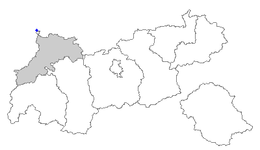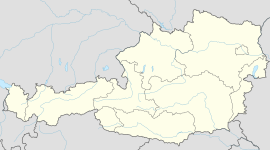
Tyrol is an Austrian federal state. It comprises the Austrian part of the historical Princely County of Tyrol. It is a constituent part of the present-day Euroregion Tyrol–South Tyrol–Trentino. The capital of Tyrol is Innsbruck.
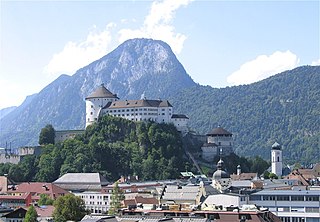
Kufstein is a town in the Austrian state of Tyrol, the administrative seat of Kufstein District. With a population of about 20,000 it is the second largest Tyrolean town after the state capital Innsbruck. The greatest landmark is Kufstein Fortress, first mentioned in the 13th century. The town was the place of origin of the Austrian noble family Kuefstein.

Reutte is a town in the Austrian state of Tyrol. It is the administrative center of the Reutte district. Reutte is located on the Lech, and has a population of 6,704.

Lienz is a medieval town in the Austrian state of Tyrol. It is the administrative centre of the Lienz district, which covers all of East Tyrol. The municipality also includes the cadastral subdivision of Patriasdorf.

Kleinwalsertal is a valley in the Austrian province of Vorarlberg and part of the Bregenz district. It includes the municipality of Mittelberg and consists of three villages along the River Breitach. Due to the geographic location in the Allgäu Alps with its alpine terrain, the Kleinwalsertal has no direct traffic connection to the rest of Vorarlberg. It is accessible only via Oberstdorf, Germany, to the north, and thus is an Austrian "practical exclave" or "pene-exclave".

Lofer is a market town in the district of Zell am See in the Austrian state of Salzburg.

Schärding is a town in the northern Austrian state of Upper Austria, the capital of the district of the same name, and a major port on the Inn River. Historically, it was owned by the Wittelsbach family, which is reflected in the town's architecture.

Sillian is a market town in the district of Lienz, in the Austrian state of Tyrol.

Obertilliach is a municipality in the district of Lienz, in the Austrian state of Tyrol.
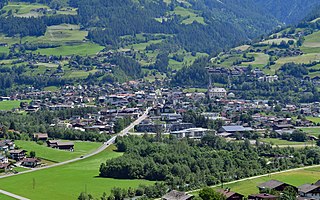
Matrei in Osttirol is a market town in the Lienz District in the Austrian state of Tyrol. It is situated about 29 km (18 mi) north of Lienz within the Hohe Tauern mountain range of the Central Eastern Alps. Its municipal area comprises parts of the Granatspitze Group and the Venediger Group, with the Großvenediger peak as its highest point. The population largely depends on tourism, seasonal agriculture and forestry.

Vils is a town in the district of Reutte in the Austrian state of Tyrol. It has a long, rich history of ten or more generations of excellent luthiers. Most prominent among those of the Rief family is Dominicus Rief. Examples of his work are in the museum there.
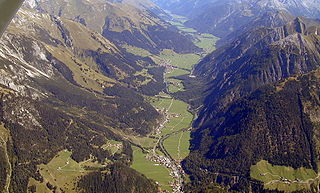
Steeg is a municipality in the district of Reutte in the Austrian state of Tyrol.

Pflach is a municipality in the district of Reutte in the Austrian state of Tyrol. It is 3 km north of the centre of Reutte town, and 2.5 km south of the German border.

Nesselwängle is a municipality in the district of Reutte in the Austrian state of Tyrol.
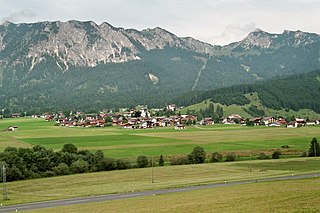
Grän is a municipality in the district of Reutte in the Austrian state of Tyrol.
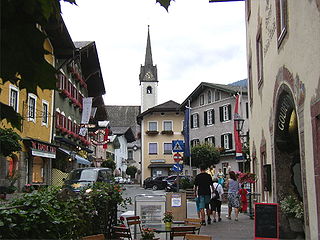
Golling an der Salzach is a market town in the Hallein district of Salzburg, Austria.

Mittelberg is a municipality and a village in the district of Bregenz in the Kleinwalsertal, in the Austrian state of Vorarlberg. It is accessible by road only from Germany.

Sibratsgfäll is a municipality in the district of Bregenz in the Austrian state of Vorarlberg.

Sorgschrofen is a 1,635-metre-tall (5,364 ft) mountain in the Allgäu Alps of Bavaria, Germany. A lower summit of Sorgschrofen is the 1,613-metre-tall (5,292 ft) Zinken. There is a summit cross on both Sorgschrofen and Zinken.

The border between the modern states of Austria and Germany has a length of 815.9 km (507.0 mi), or 815.0 km (506.4 mi) respectively. It is the longest international border of Austria and the second longest border of Germany with another country.

